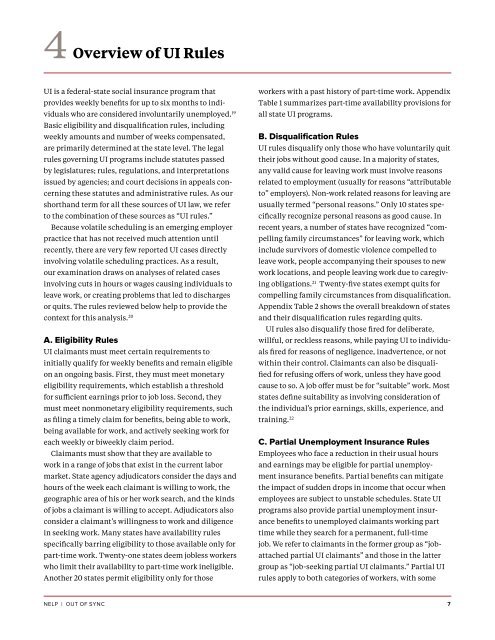Out of Sync
Out-of-Sync-Report
Out-of-Sync-Report
- No tags were found...
Create successful ePaper yourself
Turn your PDF publications into a flip-book with our unique Google optimized e-Paper software.
4 Overview <strong>of</strong> UI RulesUI is a federal-state social insurance program thatprovides weekly benefits for up to six months to individualswho are considered involuntarily unemployed. 19Basic eligibility and disqualification rules, includingweekly amounts and number <strong>of</strong> weeks compensated,are primarily determined at the state level. The legalrules governing UI programs include statutes passedby legislatures; rules, regulations, and interpretationsissued by agencies; and court decisions in appeals concerningthese statutes and administrative rules. As ourshorthand term for all these sources <strong>of</strong> UI law, we referto the combination <strong>of</strong> these sources as “UI rules.”Because volatile scheduling is an emerging employerpractice that has not received much attention untilrecently, there are very few reported UI cases directlyinvolving volatile scheduling practices. As a result,our examination draws on analyses <strong>of</strong> related casesinvolving cuts in hours or wages causing individuals toleave work, or creating problems that led to dischargesor quits. The rules reviewed below help to provide thecontext for this analysis. 20A. Eligibility RulesUI claimants must meet certain requirements toinitially qualify for weekly benefits and remain eligibleon an ongoing basis. First, they must meet monetaryeligibility requirements, which establish a thresholdfor sufficient earnings prior to job loss. Second, theymust meet nonmonetary eligibility requirements, suchas filing a timely claim for benefits, being able to work,being available for work, and actively seeking work foreach weekly or biweekly claim period.Claimants must show that they are available towork in a range <strong>of</strong> jobs that exist in the current labormarket. State agency adjudicators consider the days andhours <strong>of</strong> the week each claimant is willing to work, thegeographic area <strong>of</strong> his or her work search, and the kinds<strong>of</strong> jobs a claimant is willing to accept. Adjudicators alsoconsider a claimant’s willingness to work and diligencein seeking work. Many states have availability rulesspecifically barring eligibility to those available only forpart-time work. Twenty-one states deem jobless workerswho limit their availability to part-time work ineligible.Another 20 states permit eligibility only for thoseworkers with a past history <strong>of</strong> part-time work. AppendixTable 1 summarizes part-time availability provisions forall state UI programs.B. Disqualification RulesUI rules disqualify only those who have voluntarily quittheir jobs without good cause. In a majority <strong>of</strong> states,any valid cause for leaving work must involve reasonsrelated to employment (usually for reasons “attributableto” employers). Non-work related reasons for leaving areusually termed “personal reasons.” Only 10 states specificallyrecognize personal reasons as good cause. Inrecent years, a number <strong>of</strong> states have recognized “compellingfamily circumstances” for leaving work, whichinclude survivors <strong>of</strong> domestic violence compelled toleave work, people accompanying their spouses to newwork locations, and people leaving work due to caregivingobligations. 21 Twenty-five states exempt quits forcompelling family circumstances from disqualification.Appendix Table 2 shows the overall breakdown <strong>of</strong> statesand their disqualification rules regarding quits.UI rules also disqualify those fired for deliberate,willful, or reckless reasons, while paying UI to individualsfired for reasons <strong>of</strong> negligence, inadvertence, or notwithin their control. Claimants can also be disqualifiedfor refusing <strong>of</strong>fers <strong>of</strong> work, unless they have goodcause to so. A job <strong>of</strong>fer must be for “suitable” work. Moststates define suitability as involving consideration <strong>of</strong>the individual’s prior earnings, skills, experience, andtraining. 22C. Partial Unemployment Insurance RulesEmployees who face a reduction in their usual hoursand earnings may be eligible for partial unemploymentinsurance benefits. Partial benefits can mitigatethe impact <strong>of</strong> sudden drops in income that occur whenemployees are subject to unstable schedules. State UIprograms also provide partial unemployment insurancebenefits to unemployed claimants working parttime while they search for a permanent, full-timejob. We refer to claimants in the former group as “jobattachedpartial UI claimants” and those in the lattergroup as “job-seeking partial UI claimants.” Partial UIrules apply to both categories <strong>of</strong> workers, with someNELP | OUT OF SYNC 7


